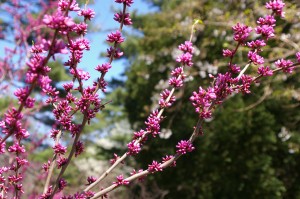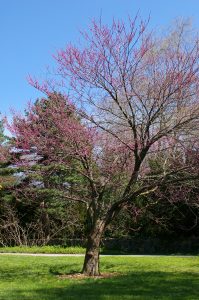designed for the way women work.

Cercis Canadensis and Cercis Chinensis
Category: Presenting "The Curious Gardener"

Have you heard of the Cercis canadensis (Eastern Redbud) or Cercis chinensis (Chinese Redbud) before? These two medium to large sized plants bloom with bold pink/magenta-colored flowers that are a real treat to any garden or lawn. If you are looking for a colorful addition to your home’s exterior, you simply can’t go wrong with either of these choices. Here we’ll take a closer look at both Cercis canadensis and Cercis chinensis, covering some of the unique characteristics associated with them.

Cercis Canadensis
Also known as the Eastern Redbud, Cercis canadensis is a deciduous plant that’s native to North and Central America. It features a short trunk that twists out where the flower-producing branches originate.
In terms of size, Cercis canadensis can grow to impressive heights of 25-30 feet with a 23-33 foot spread. Of course, the most attractive feature of this large shrub are the flowers that are typically pink to light magenta in color. With the dark grey bark contrasting against it, the flowers on Cercis canadensis are quite pleasing to look at, which is one of the reasons why so many homeowners choose to grow them on their property.
Cercis ccanadensis blooms during April and can be grown in either full sun or partial shade. Although they are considered a “low-maintenance” plant, you’ll need to ensure the soil is moist to create a habitable environment for Cercis canadensis to grow.
Cercis Chinensis
Cercis chinensis, or Chinese Redbud, is similar in appearance to the Eastern Redbud but with some notable differences that can’t be overlooked. For starters, Cercis chinensis trees can grow to heights of 50 feet, which is nearly twice the size of the Eastern Redbud. Cercis chinensis shrubs, however, grow slightly smaller with a height of just 15-25 feet. The flowers on Cercis chinensis are also a bit darker and more purple colored, blooming in pea-shaped pods.
As the name suggests, the Chinese Redbud is native to the region of China where some of the tallest specimens have been recorded. They’ve since been introduced into the U.S. with success but grow much smaller in more of a shrub-like fashion. They are a fairly low-maintenance plant that can be grown in either full sun or partial shade, much like the Cercis chinensis previously mentioned.
Cercis chinensis blooms between the end of March to early April. Its flowers will remain open for approximately 2-3 weeks before they are covered by the less-vibrant foliage.



Lovely!